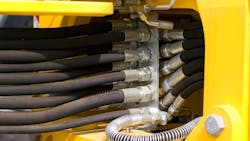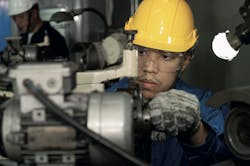Extending Hydraulic Hose Life: Going Beyond Standard Expectations
No hydraulic hose lasts forever. Sooner or later it will succumb to factors that can include fatigue, abrasion, temperature, ultraviolet light, or plain and simple aging. However, by following a few simple rules, it is possible to extend the life of a hydraulic hose considerably, enabling users to maintain machine uptime and productivity while minimizing maintenance costs.
Consider a large construction vehicle like an excavator or an agricultural machine such as a combine harvester — the cost of downtime due to a failed hydraulic hose can prove enormously expensive.
There are many other costs too, including those associated with cleaning up, disposing of, and replacing spilled hydraulic fluid. There may even be damage to other components: some pumps and motors are vulnerable to a sudden loss of working pressure, for example.
In short, unplanned stoppages impact productivity, costing many hours and sometimes days if a replacement hose is not readily available. One of the keys to avoiding this expensive scenario lies in astute hose selection, with premium hoses providing a service life far in excess of standard counterparts.
Replacing a standard hose every 3 months, for example, comes with many costs. The expense associated with ongoing hose replacement, maintenance labor, and downtime will far outweigh the slightly higher purchase price of the premium hose. Moreover, many hydraulic hose locations require the disassembly of other machine equipment to gain access, incurring even more time and expense.
Proper Hose Routing is the Pathway to Success
Correct hose routing provides another way to promote long hose life as it avoids any opportunity for external damage through kinking, abrading, or crushing. Adhering to guidance on bend radius and avoiding any twist will give the hose its best chance of meeting the manufacturer’s predicted service life. Just 5 degrees of twist per foot (0.3 m) can reduce hose service life by 70%, while 7 degrees can lead to a 90-95% reduction.
Proper routing also means preventing any potential for abrasion due to contact with other hose lines or nearby equipment. Sometimes, however, this is simply unavoidable, necessitating the use of other solutions. These include investing in a hose developed specifically to provide better abrasion resistance in comparison with standard hoses. Another option is the use of protective sleeves, springs, or shields made from steel or plastic, which should also be available from the hose manufacturer.
Any hose exposed to sunlight for long periods can also suffer from short life due to degradation by UV radiation. The outer cover will become brittle, start to crack, and fall away. This effect exposes the steel-wire reinforcement to environmental conditions, promoting corrosion and premature failure.
Again, a premium hose will offer higher resistance to UV light than a standard hose, helping to maximize service life. To help identify this issue before it turns into a costly repair, a change in color of the outer cover and marking is often a good indicator that UV light is having an undesirable effect.
Use Hydraulic Hoses Which Meet or Exceed Industry Standards
International and European hose standards (EN, SAE, ISO) set out the criteria for factors such as pressure, bend radius, abrasion, temperature, ozone, and many other parameters. These standards stipulate the requirements that every accredited hydraulic hose needs to meet.
However, some manufacturers look to develop hydraulic hoses with properties that exceed the specifications set out in industry standards. One such manufacturer is Danfoss Power Solutions. The company sees the standard not as a target to match, but an objective to surpass. For instance, Danfoss can offer hydraulic hose solutions that exhibit far less abrasive wear (after a specified number of cycles) than the figure set out in the applicable standard.
Of course, regardless of hose performance specifications, service life is somewhat beholden to the specific application. A hose serving in a system under constant (static) working pressure has an easier time than one subject to fluctuating (dynamic) pressure. Here, data from the impulse testing of a hydraulic hose provides an extremely useful way to evaluate its reliability and predicted service life.
Impulse testing subjects the hydraulic hose to repeated high- and low-pressure cycles, simulating dynamic-pressure applications such as those seen in excavator operations. A standard two-wire braided hydraulic hose according to EN857 2SC, for example, has to meet an impulse testing requirement of 200,000 cycles. However, Danfoss has products in its premium range of hydraulic hoses that offer up to 1 million impulse cycles.
READ MORE: Why Do Some Hydraulic Hoses Outperform Others?
Inspection and Maintenance Ensure Hose Longevity
If an original equipment manufacturer or maintenance team follows the guidance of the hose manufacturer and the applicable standard, the hose will likely see out its estimated service life. In such cases, there is little need for maintenance beyond scheduled visual inspection.
When replacement is required, a correctly stored spare hose will again provide the maximum opportunity to reach its expected service life. Hoses can often sit in stock for a number of years, which means care is required to avoid any inadvertent acceleration of the aging process through poor storage practices.
If a warehouse does not have climate control, for example, hoses can age faster upon exposure to extreme temperatures in winter and summer. Instead, maintaining storage temperature at 0-25 C (0-77 F) is far more conducive to long life. Users should also keep hose out of direct sunlight, and away from nearby chemicals or solvents.
Again, selecting premium hoses will provide greater resistance to any potential for aging while in storage.
What Do Premium Hydraulic Hoses Offer?
Ultimately, there are many factors that distinguish a hose as premium, including pressure, temperature resistance, flexibility (bend radius), and service life. At Danfoss Power Solutions, the principal premium range is Aeroquip, which excels in all four criteria.
The Aeroquip by Danfoss EC881 Dynamax hose, for instance, is a two-wire braided hose qualified to 1 million impulse cycles. This durable and abrasion-resistant hose delivers a lighter and more flexible option for high-pressure applications typically reliant on four-wire spiral hose. It outperforms standard EN857 2SC hose in pressure rating, operating temperature, impulse life, and abrasion resistance. Aeroquip EC881 hose provides eight times more abrasion resistance than EN857 2SC alternatives.
Following the guidance set out in this article will help keep hydraulic machinery running, saving both time and money.
If unsure, the recommendation in all instances is to contact a reputable hose manufacturer or its local accredited representative which will be able to advise on the optimal solution for the application.
This article was written and contributed by Salih Karayağız, product manager and application engineering manager, Danfoss Power Solutions.
About the Author

Salih Karayağız
Product Manager and Application Engineering Manager, Danfoss Power Solutions
Salih Karayağız is Product Manager for the Rubber Hydraulic Hose and Fittings (RHHF) business unit and Application Engineering Manager for Danfoss Power Solutions’ Fluid Conveyance (FC) division in EMEA.
In this role he is responsible for the overall product strategy for all Rubber Hydraulic Hose and Fittings brands of Danfoss across the EMEA region. This includes implementation of growth tactics to drive market share improvement and product profitability with close collaboration with Engineering, Marketing, and Sales Development teams as wells as customers.
In his role as Application Engineering Manager, he is leading a team of eight Application Engineers and is responsible to deliver the highest possible value for customer requests within a short time frame.
Karayağız began his career in 2011 as a Field and Application Engineer at Eaton’s Hose Assembly plant in Baden-Baden, Germany. In 2016 he moved to Eaton’s hose manufacturing plant in Çerkezköy, Türkiye as Product Manager and completed several new product launches for Aeroquip®, Winner® and SEL® brands.
Karayağız holds an MBA in General Management from the University of Applied Sciences, Hamburg, as well as a Bachelor of Engineering in Mechanical Engineering from Baden-Wuerttemberg Cooperative State University, Karlsruhe.

Leaders relevant to this article:



